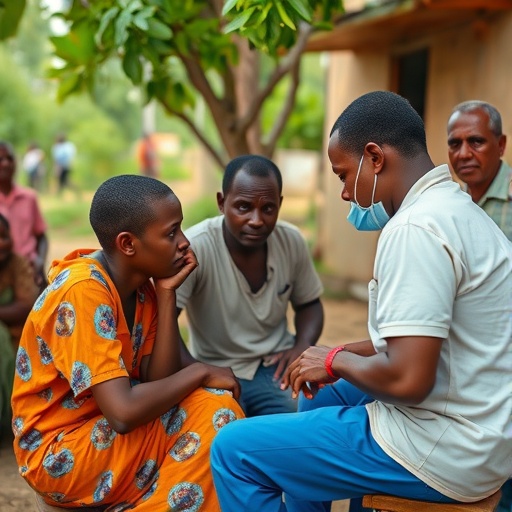Social Behavior and Disease Spread in Low-Income Countries – Bioengineer.org

Report on Social Behavior and Infectious Disease Transmission in Low- and Middle-Income Countries (LMICs)
Introduction: Aligning Public Health with Sustainable Development Goals
A study published in Nature Communications, titled “Characterizing social behavior relevant for infectious disease transmission in four low- and middle-income countries, 2021-2023,” provides critical data for advancing global health initiatives, particularly Sustainable Development Goal 3 (Good Health and Well-being). By analyzing social interaction patterns in four diverse LMICs, the research offers a new framework for developing targeted and equitable public health strategies to combat infectious diseases, a key target under SDG 3. The study, led by K.N. Nelson et al., underscores the necessity of understanding social dynamics to build resilient health systems and reduce health inequalities as outlined in SDG 10 (Reduced Inequalities).
Methodology: An Integrated Approach to Data Collection
The research employed a sophisticated, multi-faceted methodology to capture the complexity of human social networks. This approach is vital for generating the granular data needed to inform evidence-based policies that support the SDGs.
- High-Resolution Data Collection: A combination of sensor-based proximity tracking, detailed personal diaries, and retrospective interviews was used to build comprehensive interaction matrices.
- Multidisciplinary Framework: The study integrated principles from epidemiology, social science, and mathematical modeling to provide a holistic view of disease transmission dynamics.
- Comparative Analysis: By including both urban and rural settings across four LMICs, the research highlights socio-economic and cultural disparities, offering insights relevant to SDG 11 (Sustainable Cities and Communities) and the goal of ensuring health access for all.
Key Findings and Implications for Sustainable Development
The study’s findings have profound implications for achieving several SDGs by linking social structures directly to public health outcomes.
Social Network Topology and Health Equity (SDG 3, SDG 10)
The research moves beyond simple demographics to analyze the structure of social networks, revealing how they perpetuate health inequalities.
- Super-Spreader Potential: The study identified that an individual’s potential to spread disease is heavily influenced by their position within a social network (e.g., occupational roles), not just biological factors. This finding allows for interventions that are more targeted and less disruptive, promoting health equity (SDG 10).
- Urban-Rural Disparities: Contact rates were significantly higher in dense urban settings, particularly in workplaces and on public transport. In contrast, rural areas showed distinct community-cluster interactions. This data is crucial for designing context-specific health interventions that support both urban and rural populations, in line with SDG 3 and SDG 11.
Demographic and Gendered Patterns in Transmission (SDG 3, SDG 5)
Understanding how contact patterns differ across demographic groups is essential for creating inclusive and effective public health policies.
- Age-Specific Contacts: The research detailed nuanced contact patterns among children and adolescents, providing critical evidence for policies regarding school closures and vaccination priorities, directly impacting the well-being of younger populations (SDG 3).
- Gendered Interactions: The study revealed distinct social contact behaviors between men and women, shaped by cultural and occupational roles. This highlights the need for gender-sensitive public health strategies, directly supporting SDG 5 (Gender Equality) by ensuring that interventions do not disproportionately burden one gender.
- Temporal Dynamics: Transmission potential fluctuates with cultural events, market days, and holidays. Aligning public health campaigns with these social calendars can significantly improve their effectiveness.
Mobility and Cross-Jurisdictional Cooperation (SDG 11, SDG 17)
The study mapped mobility patterns, showing their substantial contribution to the regional spread of infections and underscoring the need for collaborative action.
- Corridors of Disease Risk: GPS data identified transportation and market hubs as corridors for heightened disease transmission that cross administrative boundaries.
- Partnerships for Health: These findings advocate for cross-jurisdictional coordination in disease control, reinforcing the importance of SDG 17 (Partnerships for the Goals) to build effective, large-scale public health responses.
Conclusion: Enhancing Global Health Security through Social Insight
This research represents a paradigm shift in infectious disease epidemiology, demonstrating that a deep understanding of social behavior is fundamental to achieving global health targets. By providing detailed, context-specific data, the study equips policymakers with the tools to design more effective, equitable, and efficient public health interventions. Integrating these social insights into epidemic preparedness is essential for making progress on SDG 3 and building resilient health systems capable of protecting vulnerable populations and advancing global health security.
Analysis of Sustainable Development Goals in the Article
1. Which SDGs are addressed or connected to the issues highlighted in the article?
-
SDG 3: Good Health and Well-being
This is the primary SDG addressed. The article’s core focus is on understanding and mitigating the spread of “infectious disease transmission” to improve public health outcomes, particularly in low- and middle-income countries (LMICs). The research aims to equip “public health authorities with powerful tools to craft…effective disease prevention policies,” directly contributing to the goal of ensuring healthy lives.
-
SDG 10: Reduced Inequalities
The study explicitly highlights and analyzes inequalities that affect disease transmission. It points out “disparities in contact networks” between urban and rural environments, age-specific patterns, and “gendered patterns of social interaction.” By advocating for tailored interventions instead of “blanket policies,” the research aims to create more equitable health outcomes and reduce the disproportionate impact of diseases on vulnerable populations.
-
SDG 5: Gender Equality
The article connects to this goal by identifying that “men and women engage in distinctly different contact behaviors shaped by occupational roles and cultural practices.” This finding underscores the need for “gender-sensitive public health interventions,” ensuring that disease control strategies are effective for everyone and do not inadvertently perpetuate gender-based disparities in health.
-
SDG 11: Sustainable Cities and Communities
The research addresses this goal by examining disease dynamics in “densely populated urban areas,” including contact rates in “public transportation.” By mapping mobility networks and identifying “corridors of heightened disease risk,” the study provides insights for making cities and human settlements safer and more resilient to health crises like epidemics.
-
SDG 9: Industry, Innovation, and Infrastructure
The article showcases scientific innovation by using “sophisticated data collection methods, including high-resolution diaries, sensor-based proximity tracking,” and advanced “mathematical modeling.” This multidisciplinary approach and embrace of “technological innovations set a new standard for the future of epidemiological investigations,” aligning with the goal of enhancing scientific research and technological capabilities.
2. What specific targets under those SDGs can be identified based on the article’s content?
SDG 3: Good Health and Well-being
-
Target 3.3: By 2030, end the epidemics of AIDS, tuberculosis, malaria and neglected tropical diseases and combat hepatitis, water-borne diseases and other communicable diseases.
- The article directly supports this target by investigating the “transmission of contagious diseases” and providing a framework to “combat” them more effectively. The entire study is designed to improve the understanding and control of infectious diseases, which is the essence of this target.
-
Target 3.d: Strengthen the capacity of all countries, in particular developing countries, for early warning, risk reduction and management of national and global health risks.
- The research aims to strengthen the capacity of LMICs by providing tools that “refine forecast accuracy” and enable “more targeted mitigation strategies.” It equips public health authorities for “epidemic preparedness and response,” directly contributing to risk reduction and management of health crises.
SDG 10: Reduced Inequalities
-
Target 10.2: By 2030, empower and promote the social, economic and political inclusion of all, irrespective of age, sex, disability, race, ethnicity, origin, religion or economic or other status.
- The study’s findings on age-specific, gendered, and urban-rural disparities in social contact provide the evidence base needed to design inclusive public health policies. By moving away from “blanket policies based solely on demographics,” the research promotes interventions that are equitable for all groups.
SDG 5: Gender Equality
-
Target 5.5: Ensure women’s full and effective participation and equal opportunities for leadership at all levels of decision-making in political, economic and public life.
- While not about leadership directly, the article’s call for “gender-sensitive public health interventions” is a crucial step toward ensuring health policies are designed with women’s specific social and occupational contexts in mind (e.g., “prolonged household contacts”). This ensures their needs are addressed in public health decision-making.
3. Are there any indicators mentioned or implied in the article that can be used to measure progress towards the identified targets?
For Target 3.3 (End epidemics)
- Implied Indicator: Contact rates and transmission potential. The article discusses measuring “contact rates” in different settings and how social calendars create “periodic oscillations in transmission potential.” Tracking these metrics would serve as a leading indicator for measuring the risk of disease spread and the effectiveness of interventions designed to reduce it.
For Target 3.d (Strengthen capacity)
- Implied Indicator: Forecast accuracy of epidemiological models. The article explicitly states that incorporating its detailed contact data is “expected to refine forecast accuracy.” An improvement in the accuracy of disease spread predictions would be a direct measure of a country’s strengthened capacity for health risk management.
For Target 10.2 (Reduce inequalities)
- Implied Indicator: Disparities in health outcomes between social groups. The article identifies disparities in contact networks between urban/rural, male/female, and different age groups. Progress towards this target could be measured by a reduction in the gap in infection rates or disease burden between these groups following the implementation of tailored, equitable interventions.
4. Table of SDGs, Targets, and Indicators
| SDGs | Targets | Indicators (Implied from Article) |
|---|---|---|
| SDG 3: Good Health and Well-being | Target 3.3: End the epidemics of… communicable diseases. | Measurement of contact rates and transmission potential within specific communities to pre-emptively assess and mitigate outbreak risk. |
| SDG 3: Good Health and Well-being | Target 3.d: Strengthen the capacity of all countries… for early warning, risk reduction and management of… health risks. | Improvement in the forecast accuracy of epidemiological models used for public health planning and response. |
| SDG 10: Reduced Inequalities | Target 10.2: Empower and promote the social… inclusion of all, irrespective of age, sex… or other status. | Reduction in the disparity of infection rates between different demographic groups (e.g., urban vs. rural, men vs. women) following the implementation of tailored interventions. |
| SDG 5: Gender Equality | Target 5.5: Ensure women’s full and effective participation… in public life. | The number and scope of “gender-sensitive public health interventions” developed and implemented by health authorities. |
| SDG 11: Sustainable Cities and Communities | Target 11.5: Significantly reduce the number of deaths and people affected… by disasters. | Identification and mitigation of risk within mapped “corridors of heightened disease risk” in urban and transport networks. |
Source: bioengineer.org
What is Your Reaction?
 Like
0
Like
0
 Dislike
0
Dislike
0
 Love
0
Love
0
 Funny
0
Funny
0
 Angry
0
Angry
0
 Sad
0
Sad
0
 Wow
0
Wow
0



















































.jpg.webp?itok=0ZsAnae9#)

























